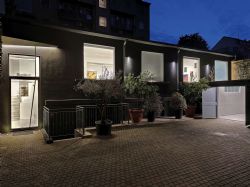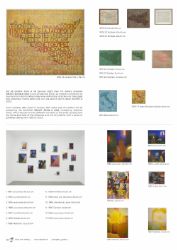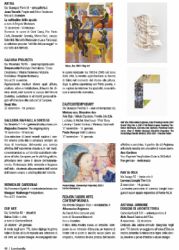
Dal 28 ottobre 2022 al 28 gennaio 2023, Dep Art Gallery presenta SALVO. Sicilie e città, a cura di Gianluca Ranzi. La mostra si concentra su due momenti distinti della produzione dell’artista: le Sicilie e le Italie degli anni Settanta e il tema della città, con una serie di dipinti datati dal 1983 al 2003.
SALVO. Sicilie e città si inserisce in un percorso di studio e ricerca che Dep Art Gallery porta avanti da diversi anni sull’opera di Salvo, nome d’arte di Salvatore Mangione (Leonforte, 1947 – Torino, 2015), già protagonista di tre mostre personali in galleria nel 2007, 2010 e 2017. Per questa quarta monografica si vuole offrire uno sguardo inedito su una produzione più rara dell’artista, nel momento del ritorno alla pittura dopo la prima esperienza con l’arte povera, esplorando da un lato la complessità della sua ricerca pittorica – nella relazione tra spazialità, resa della luce e sensibilità cromatica – e dall’altro la personale rilettura della tradizione pittorica classica.
A metà degli anni Settanta, Salvo dipinge le prime Italie e Sicilie, delle quali la mostra presenta una preziosa selezione di olii di grandi e piccole dimensioni oltre ad alcuni disegni. Queste opere giocano con le silhouette delle mappe geografiche alle quali viene sovrapposta una griglia, come di meridiani e paralleli, riempita dalle lettere che compongono i nomi di grandi artisti, filosofi, scrittori italiani di ogni epoca – ad esempio nell’opera 20 Siciliani del 1975 oppure Italia del 1975 – ai quali Salvo fa sempre seguire il suo, secondo una strategia creativa di affermazione del sé. Si tratta di opere che uniscono l’esercizio di una concettualità autoreferenziale e sottilmente autoironica alla riscoperta della pratica della pittura, in netto anticipo rispetto alle tendenze successive dell’arte internazionale.
La seconda parte della mostra è dedicata alla produzione pittorica avviata dagli anni Ottanta. Attraverso una selezione di dipinti su tela datati dal 1983 al 2003 la mostra si concentra sull’indagine condotta sulla raffigurazione della città. In questi lavori diventano centrali la sintesi delle forme, l’attenzione alla prospettiva, lo studio del colore tra le variazioni di ombre e luci. Sospese tra realtà e immaginazione, le ambientazioni cittadine, spesso notturne, diventano un pretesto per rappresentare i bagliori di luce di lampioni, neon e autovetture che si stagliano su imponenti edifici trasformati in puri solidi geometrici, come ad esempio in Periferia del 1986 o nel grande dipinto Senza titolo del 1988, dove è ritratto uno scorcio di Firenze nel quale si riconosce il Ratto delle Sabine di Giambologna.
Spiega il curatore Gianluca Ranzi: “In queste opere la rappresentazione è sempre al servizio di un’idea dell’arte che sa andare oltre il mondo delle apparenze e delle cose, per approdare alla definizione di una nuova famiglia di forme, un depurato mentale della visione eclettica e colta dell’artista, che unisce la realtà al sogno, la solidità architettonica agli enigmi della luce, l’oggettività topografica all’invenzione poetica soggettiva”.
Affiancando questi due cicli di opere, la mostra diviene così un viaggio attraverso le Sicilie e i sogni urbani ad occhi aperti dell’artista, immagini riunite e trasformate dalla sua mente mobilissima che si sposta liberamente all’interno dei codici dell’arte, arricchita da un’esecuzione manuale raffinata e ben temperata.
La mostra è accompagnata da un catalogo bilingue italiano e inglese che presenta in maniera esaustiva l’intero percorso artistico di Salvo insieme ai libri e alle mostre ad oggi dedicati all’autore.
Note biografiche
SALVO (Leonforte, 1947 – Torino, 2015)
Salvo, nome d’arte per Salvatore Mangione, nasce a Leonforte in provincia di Enna nel 1947. Nel 1956, si trasferisce con la famiglia da Catania a Torino, sua città d’adozione. Dal 1968 entra nella galleria di Gian Enzo Sperone con altri protagonisti dell'Arte Povera: Merz, Paolini, Penone, Pistoletto, Zorio e Boetti. Proprio con Boetti condivide lo studio fino al 1971. Salvo si esprime inizialmente attraverso manipolazioni fotografiche e effettuando delle “sostituzioni”, idea che riprenderà anche in seguito, realizza le lapidi in marmo e i “tricolore”, utilizzando diversi media. Sono già presenti i temi della ricerca dell’io, l’autocompiacimento narcisistico, il rapporto con il passato e la storia della cultura, elementi essenziali della sua ricerca successiva. Nel 1973 Salvo torna alla pittura, per non abbandonarla mai più, dedicandosi a una serie di lavori d'apres, dove spiccano il confronto con i maestri classici e i temi mitologici. Quasi in parallelo si confronta con le serie delle Sicilie e delle Italie, in cui elenca i nomi di personaggi storici nelle mappe geografiche, e tra i quali pone sempre il proprio. Città, valli e paesaggi dei suoi viaggi sono tra i soggetti iconici della sua pittura, interpretati più nelle forme e nei colori che nei particolari non essenziali, al punto di sviluppare un linguaggio che è sintesi della sua pratica stilistica ed estetica. Muore a Torino nel 2015.
Le opere di Salvo sono state esposte in importanti manifestazioni internazionali d’arte tra le quali Documenta 5 Kassel (1972), Biennale di Venezia (1976 e 1984), Quadriennale di Roma (2005 e 2020).
From October 28th 2022 to January 28th 2023, Dep Art Gallery will be presenting the exhibition SALVO. Sicilie e città, curated by Gianluca Ranzi, which focuses on two different moments of the artist’s production: the Sicilie and Italie of the Seventies and the city theme, with a series of paintings dating from 1983 to 2003.
SALVO. Sicilie e città is part of a process of study and research that Dep Art Gallery has been carrying out for several years on the work of Salvo, real name Salvatore Mangione (Leonforte, 1947 - Turin, 2015), formerly the protagonist of three solo exhibitions hosted by the gallery in 2007, 2010 and 2017. On the occasion of this fourth monographic exhibition, the aim is to offer a new look at a rarer production of the artist, who returned to painting after his first experience with Arte Povera, exploring on the one hand the complexity of his pictorial research – in the relationship between spatiality, rendering of light and chromatic sensitivity – and on the other hand his personal reinterpretation of the classical pictorial tradition.
In the mid-1970s, Salvo painted his first Italie and Sicilie, of which this exhibition presents a valuable selection of large and small oil paintings as well as some drawings. These artworks play with the silhouettes of geographical maps on which a grid, as of meridians and parallels, is superimposed, being filled with the letters that make up the names of great Italian artists, philosophers and writers of all ages – such as in the 1975 artworks 20 Siciliani or Italia – followed by Salvo’s own name, according to a creative strategy of self-affirmation. These works combine the exercise of a self-referential and subtly self-ironic conceptuality with the rediscovery of the practice of painting, well in advance of later trends in international art.
The second part of the exhibition is devoted to the pictorial production starting from the 1980s. Through a selection of paintings on canvas from 1983 to 2003, the exhibit focuses on the artist’s investigation into the representation of the city. In these works, the synthesis of forms, the attention to perspective, and the study of color among the variations of shadows and light take center stage. Suspended between reality and imagination, the cityscapes, often nocturnal, become a pretext for depicting the glow of street lamps, neon lights, and cars silhouetted against imposing buildings being transformed into pure geometric solids, such as in the 1986 Periferia or in the 1988 large painting Senza titolo, portraying, in a view of Florence, Giambologna’s Ratto delle Sabine.
As curator Gianluca Ranzi explains, “In these works, representation is always at the service of an idea of art that knows how to go beyond the world of appearances and things, to reach the definition of a new family of forms, a mental purifying of the artist’s eclectic and cultured vision, which combines reality with dreams, architectural solidity with the enigmas of light, topographical objectivity with subjective poetic invention”.
By bringing together these two cycles of artworks, the exhibition thus becomes a journey through the artist’s Sicilie and urban daydreams, as images assembled and transformed by his highly mobile mind that moves freely within the codes of art, enhanced by a fine and well-tempered manual execution.
The exhibition is accompanied by a bilingual catalog, Italian and English, providing a comprehensive presentation of Salvo’s entire artistic career along with the books and exhibitions to date dedicated to the author.
Biographical note
SALVO (Leonforte, 1947 – Turin, 2015)
Salvo, real name Salvatore Mangione, was born in Leonforte in the province of Enna in 1947. In 1956, he and his family moved from Catania to Turin, his adopted city. From 1968 he joined Gian Enzo Sperone’s gallery with other protagonists of Arte Povera: Merz, Paolini, Penone, Pistoletto, Zorio and Boetti. He shared his studio precisely with Boetti until 1971. Salvo initially expressed himself through photographic manipulations and by making “substitutions”, an idea that he would resume later; he made marble tombstones and the “tricolore” (Italian flag), using different media. The themes of the search for the self, the narcissistic self-satisfaction, the relationship with the past and the history of culture, essential elements of his later research, are already present. In 1973 Salvo returned to painting, never to abandon it again, devoting himself to a series of d’apres works, where the comparison with classical masters and mythological themes stand out. Almost in parallel he painted the series of Sicilie and Italie, in which he listed the names of historical figures in geographical maps, among which he always placed his own name. Cities, valleys and landscapes from his travels stand among the iconic subjects of his painting, being interpreted more in shapes and colors than in non-essential details, to the point of developing a language that is a synthesis of his stylistic and aesthetic practice. He died in Turin in 2015.
Salvo’s artworks have been exhibited at major international art events including Documenta 5 Kassel (1972), Venice Biennale (1976 and 1984), Rome Quadriennale (2005 and 2020).


























